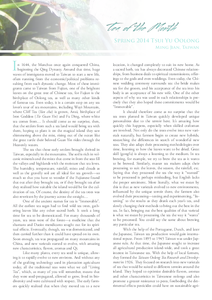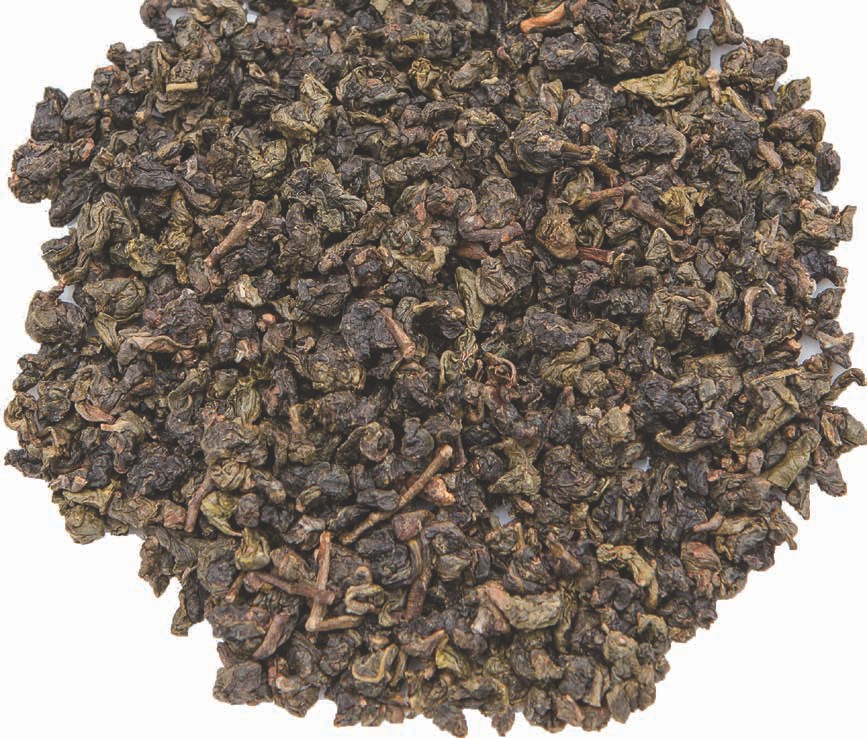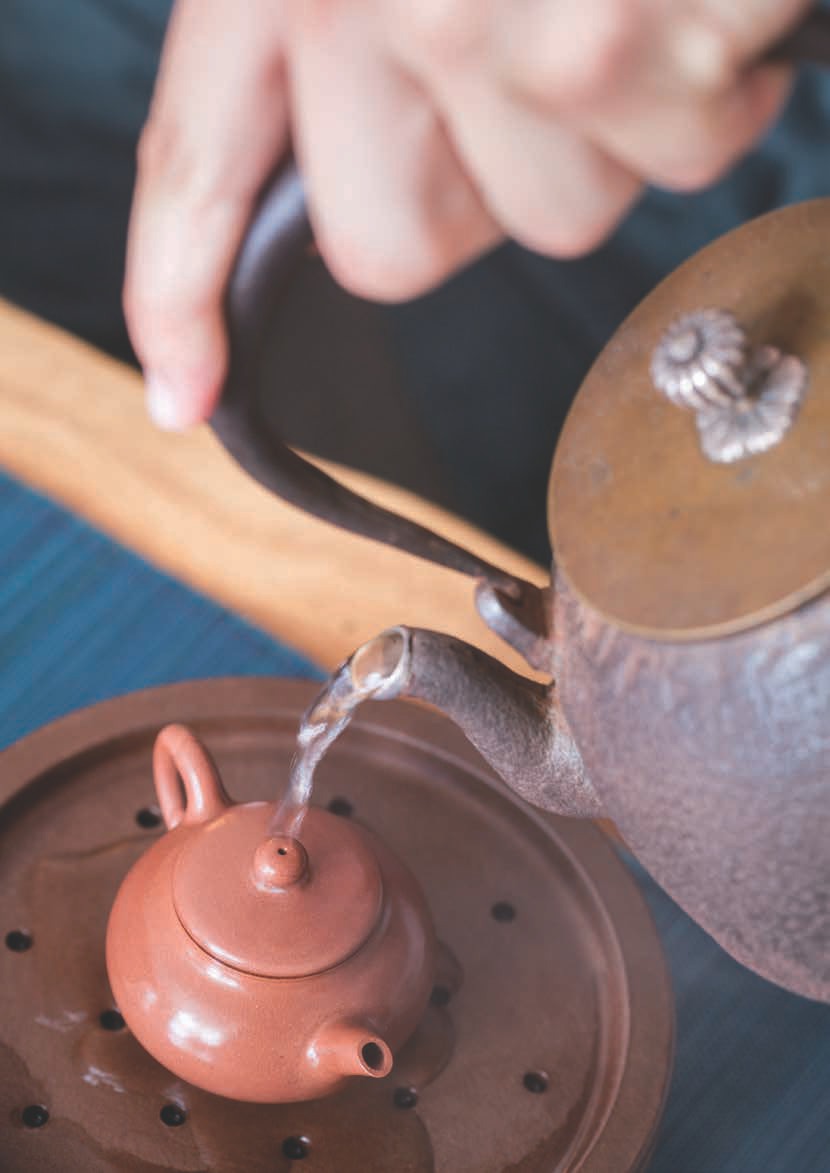
 |
|

In 1644, the Manchus once again conquered China, beginning the Qing Dynasty. Around that time, huge waves of immigrants moved to Taiwan to start a new life, often running from the economic/political problems resulting from such dynastic change. Most of these immigrants came to Taiwan from Fujian, one of the brightest leaves on the great tree of Chinese tea, for Fujian is the birthplace of Oolong tea, as well as many other kinds of famous tea. Even today, it is a certain stop on any tea lover's tour of tea mountains, including Wuyi Mountain, where Cliff Tea (Yan cha) is grown, Anxi, birthplace of Iron Goddess (Tie Guan Yin) and Fu Ding, where white tea comes from... It should come as no surprise, then, that the settlers from such a tea land would bring tea with them, hoping to plant it on the magical island they saw shimmering above the mist, rising out of the ocean like the great turtle their beloved Guan Yin rides through the Heavenly waters.
The tea that those early settlers brought thrived in Taiwan, especially in the mountains. The soil is rich in volcanic minerals and the mists that come in from the seas fill the valleys and highlands with the moisture that tea loves. The humidity, temperature, rainfall, mists and clouds as well as the gravelly soil are all ideal for tea growth - so much so that you have to wonder if the Fujianese found that out after they brought tea, or if they brought tea after they realized how suitable the island would be for the cultivation of tea. Of course, the destiny of the tea trees was also rewritten by the journey across the straight...
One of the ancient names for tea is "Immovable". All the earliest tea sages had to find wild tea trees, gathering leaves like any other sacred herb. It took a long time for tea to be domesticated. For many thousands of years, tea trees were of the forest - a medicine that the shamans and Daoist mendicants sought out for its spiritual effects. Eventually, though, tea was domesticated, and then carried further than it could have spread on its own. Soon enough, tea was propagated on many mountains in China, and new varietals started to evolve, with amazing new characteristics, flavors, aromas and Qi.
Like many plants, every tea seed is unique, allowing it to rapidly evolve to new environs. And without any of the grafting technology used in plantation agriculture today, all the traditional teas were what we call "Living Tea", which, as many of you will remember, means that they were seed-propagated, allowed to grow, lived in biodiversity and were cultivated with respect. The early farmers quickly realized that when they moved tea to a new location, it changed completely to suit its new home. As a sacred herb, tea has always decorated Chinese relationships, from business deals to spiritual transmissions, offerings to the gods and even weddings. Even today, the Chinese wedding ceremony surrounds tea: the bride makes tea for the groom, and his acceptance of the tea into his body is an acceptance of his new wife. One of the other aspects of why tea was used in such relationships is precisely that they also hoped these commitments would be "Immovable".
"Terroir" is a French word that is generally used in discussions of wine, but it is so applicable to tea as well that most tea lovers have adopted it into their discussions of the Leaf. Terroir denotes the special characteristics of a place, found in its geology, geography, climate and even cultural heritage, which interact with a cultivated plant species to create unique expressions. Terroir is the soil and weather of a particular region; the geography and culture of the people and their relationship to the plant, and even the microorganisms and their interaction with the plants. Every place has a unique soil composition, pH, minerals and climate - all of which create a distinctive tea. When we talk about a tea's terroir, we are speaking to the unique environment that created it, one which couldn't be reproduced. Even if you took a grafting of a tree and cloned it elsewhere, it wouldn't be the same since the sun would be weaker or stronger, the soil composition different, etc.
It should therefore come as no surprise that the tea trees planted in Taiwan quickly developed unique personalities due to the terroir here. It's amazing how quickly this happens, especially when skilled craftsman are involved. Not only do the trees evolve into new varietals naturally, but farmers begin to create new hybrids, researching the differences in search of wonderful new teas. They also adapt their processing methodologies over time, listening to how the leaves want to be dried. Great skill (gongfu) is always a listening to the medium. In tea brewing, for example, we try to brew the tea as it wants to be brewed. Similarly, master tea makers adapt their processing to suit the leaves, the season, the rainfall, etc. Saying that they processed the tea the way it "wanted" to be processed is perhaps misleading, but English lacks the proper sentiment. More literally, what we mean by this is that as new varietals evolved to new environments, influenced by the unique terroir there, the farmers also evolved their processing - testing and experimenting, "listening" to the results as they drank each year's tea, and slowly changing their methods to bring out the best in the tea. In fact, bringing out the best qualities of that varietal is what we mean by processing the tea the way it "wants" to be processed. You could say the same about brewing any particular tea.
With the help of the Portuguese, Dutch, and later the Japanese, Taiwan tea production would gain international repute. From 1895 to 1945 Taiwan was under Japanese rule. At that time, the Japanese sought to increase all agricultural production island-wide, and took a great interest in Taiwanese tea. With the help of local farmers, they formed the Taiwan Oolong Tea Research and Development in 1926. They focused on research into new varietals of tea that would be suited to different terroirs around the island. They hoped to optimize desirable flavors, aromas and other characteristics in Taiwanese oolongs and also promote a greater resistance to pests, foreboding the detrimental effects pesticides could have on sustainable agriculture. They also brought large-leaf seeds from Assam to central Taiwan, creating the plantations near Sun Moon Lake that were later abandoned, after the Japanese left, and have recently been tended again to produce marvelous, wild red tea.
After the Great War, much of that early research was continued and many unique varietals were created to suit Taiwan. In the 1970's the three most famous varietals unique to Taiwan were put into practice, often called the "Three Daughters": Golden Lily (Jing Shuan), Kingfisher Jade (Tsui Yu) and Four Seasons Spring (Si Ji Chun). Some of you who have been in the Hut for a while will remember that we sent you Mr. Xie's Four Seasons Spring in June of 2013. At some point, we'll also send out Golden Lily, so you'll get the chance to taste all the Three daughters.
The Three Daughters have played a large role in propelling Taiwanese tea to such prominence in the tea world over the last few decades - an eminence that has brought positive influences to the island, in the great surge of economic growth for farmers and aboriginals, as well as the development of one of the world's richest and most vibrant tea cultures, but also negative influence, for the great increase in demand for Taiwanese tea has also increased the need for agrochemicals and therefore caused a lot of environmental destruction. Now is the time for those of us who love Taiwanese tea to use its pivotal role in the tea world to begin encouraging farmers to produce the same magical varietals of tea we know and love, only in more sustainable ways! And our tea of the month helps further that dream!
Later on in this issue, we'll focus on a deeper understanding of the varietals of tea in Taiwan. For now, let's move on to our tea of the month, which is one of the Three Daughters, Tsui Yu.

"Tsui" is a very old, traditional character in Chinese which refers to the lovely blue-green color of a kingfisher's feathers and "Yu" is jade. As you look longingly into the depths of these small rolled balls of tea, you will notice a bluish green hue. Even on the trees, the leaves have a bluish-green cast to them. It is known for having the aroma of flowers and the taste of fruit. Nutty and sweet, it can often taste like seaweed, lima beans, lotus, peaches or plums, cassia or lilac, depending on where it was grown, from which season (it's terroir in other words), as well as the processing.
The quality of oolong tea is always as much dependent upon the skill of the maker as it is on the trees and terroir. Oolong is the most complicated of all tea drying, requiring more steps and a greater adaptation from season to season depending on the weather and the leaves. Our tea was grown organically in Ming Jian by our beloved Mr. Xie. And Ming Jian is home to more Tsui Yu than anywhere else in Taiwan.
Taiwanese oolong production follows the general pattern that all oolong does, with variations in the degree of oxidation or roast - making oolong the most varied genre of tea, spanning an huge spectrum of oxidation from greener oolongs, like this month's Tsui Yu, to more heavily oxidized teas like Eastern Beauty. Oolong is picked and then withered outdoors and indoors. As it is withered it goes through the most characteristic step of oolong tea: shaking. (If you are interested, you might want to check out the story of how oolong got its name in the September, 2013 issue of Global Tea Hut.) The indoor withering occurs on large, circular bamboo trays that are deftly tossed by the farmers with a skill that makes it seem simple, when in fact it is very difficult to make the leaves dance properly (you may spill them all, or even toss them in your own face as Wu De once did). The withering is to begin oxidation as well as to allow the moisture to depart the leaves so that they are limp and can be manipulated (they would break if they were rolled right after plucking). The shaking then bruises the leaves, causing cellular changes. The best tea producers can dance and shake the leaves in such a way that only the edges will be bruised, leaving a slight redness around the edges.
After withering/shaking, the tea is then fried in a dry wok to kill a green enzyme in the tea that makes it bitter. In fact, this stage is called "kill-green (sa chin)". This also arrests oxidation. This means that different degrees of withering will result in higher or lower oxidation in oolong tea. After the kill-green stage, the tea is rolled. This breaks down the cells and shapes the tea. There are two shapes of oolong tea, striped and balled. The striped teas, like Wuyi Cliff Tea, are rolled across bamboo trays with ridges to break the cells and twist them into long stripes. Balled teas, like our tea of the month, are rolled in twisted cloth that tightly compacts the tea, shaping it into small balls that unfurl when you steep the tea.
The final stage in the processing is to roast the tea dry. Some traditional oolongs then undergo a later, stronger and longer roast to deepen the aroma and flavor. Our tea, however, is a lightly-oxidize, green oolong, so the roast is just to dry the tea and seal in its freshness.
Tsui Yu is an amazing tea, especially when it is organic. It is great to drink in the summer, as it is cooling and refreshing. We find that Mr. Xie's Tsui Yu is smooth with hints of lilac, seaweed, nuts or beans. It finishes with a lasting sweetness that lingers on the breath (hui tian). The energy is bright and uplifting, reminiscent of summer skies and grassy parks. They say that all Tsui Yu has an aroma like wild flowers and flavors of fresh fruit. Do you find that in this tea?
In drinking this month's tea, you are drinking a bit of Taiwanese history, as this tea is so emblematic of this island and its tea culture. As it is home to our center, we take pride in the amazing teas and tea culture Taiwan has to offer, trying our best to expose our guests to as much as possible. Our love for Taiwan and her teas also leaves us heartbroken when we see the environmental impact unhealthy tea production has. This tea is an amazing solution: beautiful, delicious and bright tea grown completely organic and sustainably by those who are as devoted to the preservation of Nature and Taiwan as they are to tea itself! After all, the daughter is a reflection of her mother...

Through the wind soughing the pines And past the cyan bushes That cling to the cliffside, The kingfisher warbled At the passing brook. "Do you hear the distant kingfisher?" Tea asked with a sip. Straining, I listened again. "I do indeed," I replied with another draught. "Then enter there."
This month's tea is ideally brewed gongfu. As we've mentioned often before, it is difficult to provide proper brewing instructions without first knowing what kind of teaware and water you're using. For that reason, we encourage you to contact us at globalteahut@gmail.com with any specific brewing questions.
The best way to brew gongfu tea is with an Yixing pot, a tea boat of some kind and some porcelain cups. As this is a green, lightly-oxidized oolong, it is best if the water is not too hot (somewhere around 90 degrees Celsius). We recommend not using a thermometer, though. Remember, "gongfu" means "skill", it means "mastery". To master tea, you'll want to learn to use your senses. Try looking at the size of the bubbles, for example. Look for what the Chinese call "fish eye", which are the medium-sized bubbles that come before the tempest of a full boil (called "old man's hair" or "dragon water" in Chinese).
First, rinse all your teaware. Then place your tea in the pot. As we mentioned before, a good rule of thumb is to cover the bottom so that you can still see the bottom, like the first fall of autumn leaves covers the ground (such generalities will only get you so far, but it's a start). Rinse the tea, pouring the wash away quickly. Then begin steeping. Remember to shower the pot both before and after pouring (see this month's Gongfu Tea Tips). At that point, you can decant the tea into the cups in circular motions, moving from cup to cup to ensure the liquor is consistent amongst them all.
Another tip for this month's tea is to take small sips. Oolong is better enjoyed in fine, small sips, as the aroma and flavor will unfold more fully that way. Also, the Qi of oolong comes into the subtle body through the mouth and nose, in upward-moving energy.
